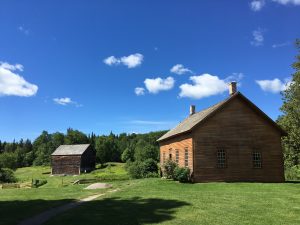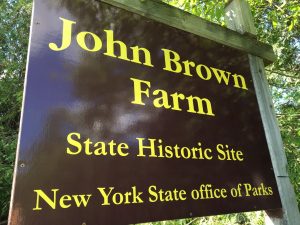There is a place in North Elba, New York, where pine trees encircle a meadow. Looming over the pines are two ski jump towers used during the 1980 Lake Placid Olympics. From the parking lot can be seen a small enclosure, a weathered barn, a wooden farmhouse, and a pond. Standing before it all is a larger-than-life statue depicting an unbowed and unbroken John Brown with his arm over the shoulder of an African American child.
My family has been vacationing in the Lake Placid region for about a decade now, yet it took us until our most recent visit in June to stop at the John Brown Farm State Historic Site. It’s not that we hadn’t known it was there or didn’t care to visit, but we certainly hadn’t anticipated that there was so much to see.

The cemetery is the first spot visitors come to at the site, appropriate for a place of pilgrimage as sacred to some visitors as Gettysburg or Antietam. And why shouldn’t it be? This is the final resting place of a man who—however controversial—went to greater lengths than almost anyone in his quest to end human bondage. If, as some Americans believe, soldiers on both sides of the Civil War can be absolved of the moral burden of their causes because they “were all Americans who fought for what they believed in,” then John Brown should be revered by all of us as an American saint. After all, he fought a system of oppressive violence with violent resistance (not always judiciously) and so earned himself an unenviable place in America’s historical consciousness. Places like Harpers Ferry National Historical Park have sought to complicate John Brown’s story and place it in the context of the struggle for racial equality, but in doing so Brown becomes a man larger than life itself. It takes another site to recall that John Brown was more than just a public figure.
For John Brown had a family. And while he and his boys were fighting in Bleeding Kansas, his wife, daughters, and sons-in-law were tending the earth at his farm in North Elba. They grew subsistence crops like potatoes, built relationships with neighboring families, and lived like thousands of other poor families in rural 19th century America. Visitors can go inside the original farmhouse where many of the Browns’ household goods remain on display. Although the radical abolitionist himself spent a total of just 3 months at the property, the land and belongings reveal much about the hardscrabble life that his family had to live in his absence. Brown’s life work demanded considerable personal sacrifice from both him and his family.

Their community was quiet but diverse and socially complex. Their neighbors included many black families, for the region was in the process of being settled by abolitionist and philanthropist Gerrit Smith. It was this project that first attracted Brown to the region and led him to purchase his own land from Smith. Today Brown’s barn contains an exhibit called “John Brown Lives!” that tells the story of those black families who took a chance on life in the Adirondack mountains. For various reasons fewer African Americans were resettled than hoped, but the exhibit concludes that to call the project a failure underestimates its significance as a stepping stone on the long road to freedom. Indeed, it gained significant attention from the likes of Frederick Douglass and other abolitionists seeking solutions to the questions of racial injustice. And just several years after the project, Gerrit Smith would help underwrite Brown’s raid on Harpers Ferry.
The site does not receive many visitors. Perhaps 50 or 75 at most. It makes for an especially poignant and private encounter with history. At the moment, the state of New York continues to recognize the national significance of this site, staffing it with four state employees to care for the land and facilities, and interpret them for visitors. Whether this arrangement can long endure is an open question, but for now the site provides a peaceful last resting place for a man who changed America and a picturesque place of reflection for those who come to pay their respects.


